#SDG Summit
Text
Strengthen the meaningful engagement of girls and young women in all areas of public life, facilitating access to decision-makers.
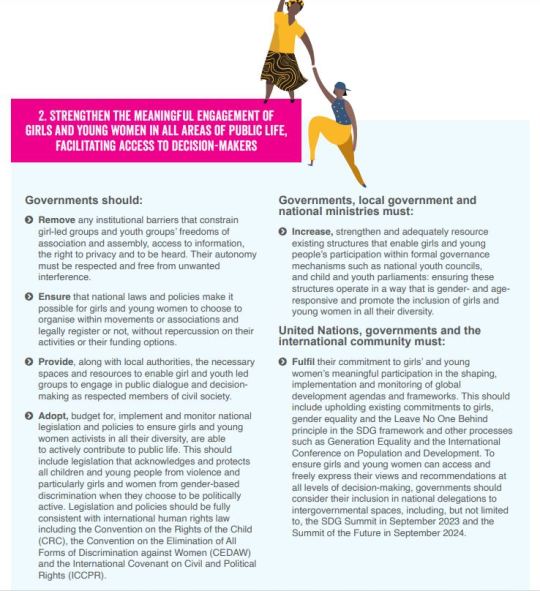
Governments should:
- Remove any institutional barriers that constrain girl-led groups and youth groups’ freedoms of association and assembly, access to information, the right to privacy and to be heard. Their autonomy
must be respected and free from unwanted interference.
- Ensure that national laws and policies make it possible for girls and young women to choose to organise within movements or associations and legally register or not, without repercussion on their
activities or their funding options.
- Provide, along with local authorities, the necessary spaces and resources to enable girl and youth led groups to engage in public dialogue and decision-making as respected members of civil society.
- Adopt, budget for, implement and monitor national legislation and policies to ensure girls and young women activists in all their diversity, are able to actively contribute to public life. This should
include legislation that acknowledges and protects all children and young people from violence and particularly girls and women from gender-based discrimination when they choose to be politically
active. Legislation and policies should be full consistent with international human rights law including the Convention on the Rights of the Child (CRC), the Convention on the Elimination of All
Forms of Discrimination against Women (CEDAW) and the International Covenant on Civil and Political Rights (ICCPR).
Governments, local government and national ministries must:
- Increase, strengthen and adequately resource existing structures that enable girls and young people’s participation within formal governance mechanisms such as national youth councils,
and child and youth parliaments: ensuring these structures operate in a way that is gender- and ageresponsive and promote the inclusion of girls and young women in all their diversity.
United Nations, governments and the international community must:
- Fulfil their commitment to girls’ and young women’s meaningful participation in the shaping, implementation and monitoring of global development agendas and frameworks. This should
include upholding existing commitments to girls, gender equality and the Leave No One Behind principle in the SDG framework and other processes such as Generation Equality and the International Conference on Population and Development. To ensure girls and young women can access and freely express their views and recommendations at all levels of decision-making, governments should consider their inclusion in national delegations to intergovernmental spaces, including, but not limited to, the SDG Summit in September 2023 and the Summit of the Future in September 2024.
#girl and youth led groups#decisionmaking#innovation for equality#international day of the girl child#adolescent girls#dayofthegirl#SDG Summit#Summit of the Future#Leave No One Behind#local government#national ministries#Convention on the Rights of the Child (CRC)#Convention on the elimination of all Forms of Discrimination against Women (CEDAW)#International Covenant on Civil and Political Rights (ICCPR)#State of the World's girls
0 notes
Text
2023 SDG Summit (Leaders' Dialogue 5 and 6 and Closing segment).
Six Leaders' Dialogues will be held to allow Heads of State and Government to set out concrete national commitments to SDG transformation. Each Leaders' Dialogue will be co-moderated by two States at the level of Head of State and Government. Participating States will intervene on the specific theme of the Leaders' Dialogue to share their concrete new commitments in the field of sustainability. The Dialogues will also feature interventions from selected representatives of the UN system, intergovernmental organizations, the private sector, civil society and academia.
3:00 p.m. – 4:30 p.m. Leaders' Dialogue 5 "Unity and Solidarity: Strengthening the multilateral system for enhanced support, cooperation, follow-up and review"
4:30p.m. – 6:00 p.m. Leaders' Dialogue 6 "Mobilizing finance and investments and the means of implementation for SDG achievement"
Closing segment: Report back from Leaders' Dialogues and other Summit components. Closing remarks by the Secretary-General and the President of the General Assembly.
0 notes
Text
(Part 6) ECOSOC Youth Forum 2024 - Youth and the Summit of the Future.
The Economic and Social Council (ECOSOC) Youth Forum 2024 will take place from 16 to 18 April 2024 at the United Nations headquarters in New York.
Watch the (Part 6) ECOSOC Youth Forum 2024 - Youth and the Summit of the Future.
#young people#2030 agenda#global goals#sdgs#poverty#resilient and innovative solutions#youth#youth2030#youth engagement#GlobalGoals#end poverty#youth empowerment#webcast#YouthForum#sustainable development goals#summit of the future
0 notes
Text
Massive investment and financial reform needed to rescue Sustainable Development Goals
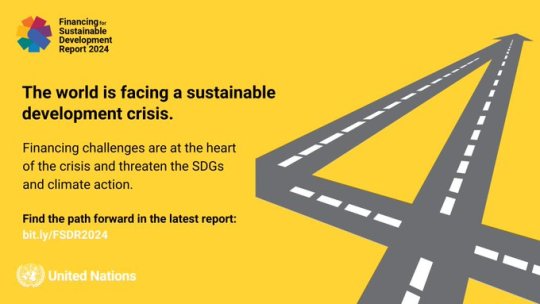
Financing for sustainable development is at a crossroads and without urgent investment, global efforts to achieve a more just and equitable world by 2030 will fail, the UN deputy chief warned on Tuesday. Presenting the latest UN report on the issue, Amina Mohammed called for “a surge in investment” and reform of the international financial system to rescue the Sustainable Development Goals (SDGs) which are woefully offtrack. World leaders adopted the 17 SDGs nearly a decade ago and they include ending extreme poverty and hunger, ensuring availability to clean water and sanitation, and reducing inequality within and among countries.
‘Finance is the crux’
“At our current rates, we estimate some 600 million people will still be living in extreme poverty beyond 2030. And as the report shows, finance is the crux of the problem,” Ms. Mohammed said, speaking at UN Headquarters in New York. The 2024 Financing for Sustainable Development Report says urgent steps are needed to mobilise financing at scale to close the development financing gap, now estimated at $4.2 trillion annually, up from $ 2.5 trillion before the COVID-19 pandemic. Meanwhile, rising geopolitical tensions, climate disasters and a global cost-of-living crisis have hit billions of people, battering progress on healthcare, education, and other development targets.
Drowning in debt
Staggering debt burdens and rising borrowing costs are large contributors to the sustainable development crisis. Estimates are that in the least developed countries, debt service will be $40 billion annually between 2023 and 2025, up more than 50 per cent from $26 billion in 2022. Stronger and more frequent climate related disasters account for more than half of the debt upsurge in vulnerable countries. Deputy Secretary-General Mohammed said roughly 40 per cent of the global population, some 3.3 billion people, live in countries where governments now spend more on interest payments than on education or health.
Meanwhile, the global economy is not supporting investment and development as it should, she noted. Average growth rates have steadily declined over the last 25 years, from over six per cent before the global financial crisis more than 15 years ago to around four per cent today.
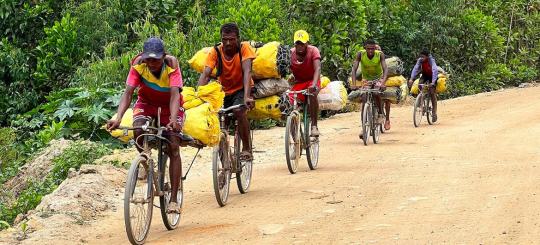
Reform outdated financial system
The report calls for scaling up public and private investment in the SDGs, highlighting the importance of reform of the development bank system. In this regard, donors also need to make good on commitments on Official Development Assistance (ODA) and climate finance. Secondly, the current international financial architecture – established nearly 80 years ago – must also be remade as it is “no longer fit for purpose”, she said, and developing countries should have a greater voice in global economic governance.
Close ‘credibility gaps’
Finally, world leaders must close “credibility gaps” and trust deficits. This is especially the case for wealthier nations, which have made promises on global governance reform, aid delivery, and domestic reforms to tackle corruption and inequality, including gender inequality. Stating that the report’s message could not be clearer, Ms. Mohammed said “we must choose now either to succeed together or we will fail together,” stressing that “failure is not an option.” The report also encourages governments to make the most of “significant opportunities ahead”, she added, pointing to major conferences such as the Summit of the Future at UN Headquarters in September and the Fourth International Conference on Financing for Development scheduled for next year.
The Summit has been described as a once-in-a-generation opportunity to enhance cooperation on critical challenges and address gaps in global governance, and to reaffirm commitments, including to the SDGs.
#un deputy secretary-general#financing for development#financing the SDGs#urgent investments#globalgoals#Close ‘credibility gaps’#close the development financing gap#summit of the future#international financial system#Official Development Assistance (ODA)
0 notes
Text
(Part 2) Action and Leadership from the Ground Up: Towards the Rescue Plan for People and the Planet.
The Local and Regional Governments Forum will therefore bring together local, regional, and national governments as well as representatives from the United Nations and other stakeholders to announce strong commitments, present coalitions for policy change, and illustrate high-impact localization policies. The Forum will also reflect on the importance of Voluntary Local and Voluntary Subnational Reviews in the acceleration of the implementation of the SDGs as reporting tools but also policy tools. The Forum will provide reflections on the constituency's priorities and aspirations for the UN Summit of the Future in 2024 and the World Social Summit in 2025.
#cities#sdg11#sustainable cities#stakeholders#agenda 2030#plenary sessions#SDG Action#sustainable development goals#sdg9#Global Task Force of Local and Regional Governments#United Cities and Local Governments#UNDESA#UN-Habitat#UNDP#Local2030 Coalition#Summit of the Future#World Social Summit
0 notes
Text
Upcoming 2023 Summits
:: By Hope Wingo Published on: July 11, 2023
The Bible tells us that a 10-king alliance will be in place in the early part of the Tribulation. Rev 17:12-14, “And the ten horns which thou sawest are ten kings, which have received no kingdom as yet; but receive power as kings one hour with the beast. These have one mind, and shall give their power and strength unto the beast. These shall make war with the Lamb, and the Lamb shall overcome them: for he is Lord of lords, and King of kings: and they that are with him are called, and chosen, and faithful.”
At first, these kings have no power, but when they receive it, they willingly turn it over to the Antichrist. Rev 17:17, “For God hath put in their hearts to fulfill his will, and to agree, and give their kingdom unto the beast, until the words of God shall be fulfilled.”
BRICS is a five-nation alliance that currently includes Brazil, Russia, India, China, and South Africa. It is being called “A New Multipolar International Order.” Their objective is power. They plan to bring about a different world order and seek to replace the power that the US dollar has over the world. They have their own currency. Since America represents the current world order, their goal is to break it down and replace it with a new world order.
We think that these ten kings might be the BRICS nations, who are planning to add five more at the BRICS Summit in Johannesburg, South Africa, in August 2023. They will call their expanded alliance BRICS+.
Note that bricks are made of clay. The 10 toes of Daniel 2:42 are described as “part of iron, and part of clay, so the kingdom shall be partly strong, and partly broken.”
The United Nations’ Sustainable Development Goals (SDG) Summit will be held on September 18-19, 2023. It is calling for all nation members to re-commit to strengthening their Agenda 2030 goals. The plan began in 2015, but the halfway point has been disappointing to them, so they are calling for all nations to re-commit to a new seven-year plan of accelerating and strengthening their existing covenant called Agenda 2030. (Please see the linked article below.)
The Secretary General of the UN has announced, “First, I urge heads of State and Government to re-commit to seven years of accelerated, sustained and transformative action, both nationally and internationally, to deliver on the promise of the SDGs.” He also stated, “I encourage Member States to adopt an ambitious and forward-looking Political Declaration and to present global and national commitments for SDG Transformation at the SDG Summit.”
This SDG Summit also coincides with the worldwide International Day of Peace, which is on September 21. The UN website, which highlights the need for Peace and Security, states, “2023 marks the midpoint of the UN Sustainable Goals. The 2023 observance of the International Day of Peace coincides with the SDG Summit on the 18th and 19th of September to mark the midpoint milestone.”
I think it is interesting that this Summit also falls on the last day of the Feast of Trumpets, which runs from September 15-17. The Jewish day begins on the evening prior, so the 17th is still ongoing until the evening of the 18th, which is the first day of the SDG Summit.
Ironically, this SDG Summit uses the tagline, “A rallying cry for leaving no one behind.” Isn’t that the Rapture warning cry – satanically twisted?
Perhaps Agenda 2030’s end goal is to fight the King of kings. We don’t know the exact date of Jesus’ death on the cross, but Satan does. He was there, and he knows that Jesus will return exactly 2,000 years (or two prophetic days) later, and at that time, the ten kings “will make war with Him…” (Rev 17:14).
If these two summits, held in the shadow of the In-Our-Face-Days-of-Lot Pride month, are not ushering in the Tribulation, then what more do we look for? In my opinion, it’s already off the charts.
Please consider all of this, and make sure – real sure – that you’re ready to leave this world.
#sdg#summit#2030#2025#brics#feast of trumpets#god#jesus#jewish#holidays#holy#days#september#rapture#world#global#day of peace#21#17#18#2023#agenda#great reset#nwo#antichrist#france#israel#russia#ukraine#china
0 notes
Text
Seventeen Goals. Seventeen digital solutions. 2.7 billion reasons to connect the world.
On 17 September 2023, ITU, together with the United Nations Family and Partners, will convene for SDG Digital Day. We will discuss how digital technologies can rescue these goals and speed up progress. As well as how to ensure the 2.7 billion people currently offline can also benefit. Be part of the solution! Join us on 17 September (in-person or virtually) to help bring the SDGs back on track and ensure a sustainable and inclusive Digital Future For All. For more information please visit: https://digital.day

youtube
#SDG Digital Day#Be part of the solutions#DigitalFutureForAll#world's offline population#internet access#digital inclusion#accessibility#universal connectivity#international telecommunication union (itu)#summit#Youtube
0 notes
Text
วว. ร่วมประชุม WAITRO Summit 2022 ส่งผลงานวิจัยประกวดโปสเตอร์ธีม SDG Impact @ เมืองเคปทาวน์ แอฟริกาใต้
วว. ร่วมประชุม WAITRO Summit 2022 ส่งผลงานวิจัยประกวดโปสเตอร์ธีม SDG Impact @ เมืองเคปทาวน์ แอฟริกาใต้
ศ. (วิจัย) ดร.ชุติมา เอี่ยมโชติชวลิต ผู้ว่าการสถาบันวิจัยวิทยาศาสตร์และเทคโนโลยีแห่งประเทศไทย (วว.) กระทรวงการอุดมศึกษา วิทยาศาสตร์ วิจัยและนวัตกรรม (อว.) พร้อมด้วย น.ส. พิมประไพ ศุภรรัตน์ นักวิเทศสัมพันธ์อาวุโส วว. เข้าร่วมงาน WAITRO Summit 2022 เป็นวันที่สอง ซึ่งจัดขึ้นระหว่างวันที่ 14-16 พฤศจิกายน 2565 ณ เมืองเคปทาวน์ ประเทศแอฟริกาใต้ โดยได้ปฏิบัติภารกิจ Workshop on Benchmarking Best RTO…

View On WordPress
0 notes
Text
This December 3rd remember that one in every five women is likely to experience disability in her life

The classroom in the Kamurasi Demonstration School in Masindi Municipality, Uganda, with the Ugandan Sign language alphabet drawn on the wall.
PHOTO:UNICEF/Uganda/Barbeyrac
United in action to rescue and achieve the SDGs for, with and by persons with disabilities
Given the multiple crises we are facing today, the world is not on track to reach numerous Sustainable Development Goals (SDGs) targets by 2030. Preliminary findings from the forthcoming UN Disability and Development Report 2023 indicate that the world is even more off-track in meeting several SDGs for persons with disabilities.
Our efforts to rescue the SDGs for, with, and by persons with disabilities, need to be intensified and accelerated, given that persons with disabilities have historically been marginalized and have often been among those left furthest behind.
A fundamental shift in commitment, solidarity, financing and action is critical. Encouragingly, with the adoption of the Political Declaration of the recent SDG Summit, world leaders have recommitted themselves to achieving sustainable development and shared prosperity for all, by focusing on policies and actions that target the poorest and most vulnerable, including persons with disabilities.
The United Nations Disability Inclusion Strategy
When launching the United Nations Disability Inclusion Strategy in June 2019, the Secretary-General stated that the United Nations should lead by example and raise the Organization’s standards and performance on disability inclusion—across all pillars of work, from headquarters to the field.
The United Nations Disability Inclusion Strategy provides the foundation for sustainable and transformative progress on disability inclusion through all pillars of the work of the United Nations. Through the Strategy, the United Nations system reaffirms that the full and complete realization of the human rights of all persons with disabilities is an inalienable, integral and indivisible part of all human rights and fundamental freedoms.
In August 2023, the Secretary-General submitted his fourth report on steps taken by the UN system to implement the UN Disability Inclusion Strategy in 2022.
Commemorative Event : UNHQ, 1 December 2023, 10am-1pm (New York Time)
The discussion will be structured around five pillars of sustainable development – People, Planet, Prosperity, Peace, and Partnerships – with a special focus on the priority areas identified in the SDG Progress Report of 2023, in the outcome document of the recent SDG Summit, in policy briefs prepared for the Summit for the Future and in the forthcoming UN Disability and Development Report 2023. For purposes of this discussion, the priority areas can be identified as gender equality (People), climate action (Planet), financing for development (Prosperity), a new agenda for peace (Peace) and strengthening multilateralism (Partnerships).
Concept note [PDF]
Did you know?
Of the one billion population of persons with disabilities, 80% live in developing countries.
An estimated 46% of older people aged 60 years and over are people with disabilities.
One in every five women is likely to experience disability in her life, while one in every ten children is a child with a disability.
#December 3#International Day of Persons with Disabilities#The United Nations Disability Inclusion Strategy#Women and disability
6 notes
·
View notes
Text
This week’s Climate Ambition Summit and the United Nations General Assembly focused on “accelerating action” on the Sustainable Development Goals (SDG) highlight what young people across the globe already know: Today’s world is marked by complex challenges—the climate crisis, increasing levels of conflict and displacement, rising authoritarianism, and the diverse social and economic effects of a global pandemic—that intersect with historical injustices, including gender-based violence and discrimination, economic inequality, ableism, and racism. These realities make up the lived experiences of today’s children and youth, yet the great majority of education systems around the world do little to prepare them to not only navigate today’s challenges, but to be agents of positive change in their own lives, in their local communities, and on the global stage.
While the past few decades have seen great strides in “getting kids in school,” we are still lagging far behind in ensuring that being in school is meaningful, that learning is relevant, and that young people themselves are engaged as active participants and decisionmakers in their own learning pathways.
Efforts focused on expanding educational opportunities for young people often overlook the importance of supporting the development and exercise of agency. A fundamental component of full and equal participation and key to educational achievement, agency refers to the power, capacity, and ability to recognize and voice one’s hopes, make decisions about one’s life, and take action in body, speech, and mind.1 Agency sits at the nexus of the individual and her community. At the personal level, agency implies the development of a diverse set of skills, knowledge, beliefs, and behaviors. Yet the ability to act upon these beliefs and behaviors is often “culturally constrained” by external forces that influence young people’s lived experiences. Feminist authors, for example, center their definitions of agency not only individually, but in community with others, recognizing that agency must be situated within larger social structures and necessarily involves an analysis of power relations impacted by class, religion, race, and gender, among other factors.
For adolescent girls around the world, agency is a practical issue rather than a theoretical concept. Every day these girls make conscious decisions about their lives and futures, in their families, schools, and communities, while they navigate larger social structures, norms, and systems. Accounting for this daily struggle is vital to improving learning opportunities and life outcomes for youth and their communities. Yet the agency of young people, especially that of girls and young women living in the most marginalized contexts, is often misunderstood, unrecognized, underdeveloped, and/or actively stifled.
Since May of 2022, the Center for Universal Education (CUE) at Brookings has worked to explore agency through the Learning and Action Alliance for Girls’ Agency (LAAGA), a community of practice comprised of 23 leaders in gender equality in and through education from 18 countries across Africa, America, Asia, and the Middle East. All LAAGA members are alumni of the Echidna Global Scholars Program, and the LAAGA initiative grew out of their desire to engage more deeply with their peers from across the globe as well as CUE’s commitment to catalyzing opportunities for collaborative learning and action.
LAAGA envisions “a world that values the knowledge and dignity of girls and young women, listens to their voices, and supports them in taking action to shape their own lives and those of their communities.” This vision, as well as LAAGA’s structure, operations, research questions, methodological approaches, analytical frameworks, evidence products, and action plans are the result of iterative processes of co-construction that are grounded in feminist and collaborative approaches to research and practice that emphasize action-reflection and participation. In partnership with CUE, LAAGA is focused on co-creating shared ideas and understandings about the development and exercise of girls’ agency within diverse contexts in the Global South, and it seeks to put these ideas into action working with girls, their families and communities, practitioners, and policymakers.
Through this co-creative process, LAAGA members identified the need to bring a critical lens to research on “girls’ agency.” This meant first questioning the very definition of agency, a concept developed primarily by researchers, funders, and policymakers situated in the geographic Global North and measured with indicators that often have very little relevance in the context of adolescent girls living in marginalized communities. For example, being without a cell phone or a bank account may be more indicative of a context marked by systemic poverty and social and economic exclusion than a “lack” of agency on the part of a girl.
Other questions In LAAGA’s early development have included: What does “agency” mean, how does that vary by context, and who gets to define that? What do we mean by “girls”? Which girls, when and why? How does agency vary from situation to situation and who or what affects this, and why? And perhaps most importantly, how might we center girls’ voices, perspectives, and lived experiences in the research process?
In response to this initial phase of critical questioning, LAAGA has spent the past year designing and conducting research that aims to understand the nuanced nature of the development and exercise of girls’ agency with and for girls in four systematically marginalized communities, including:
The Feni District of Bangladesh, a coastal community affected by floods, cyclones, and tidal surges where socioeconomically marginalized girls and their families face extreme poverty, violence, and chronic climate events.
The Karamojong region straddling the borders of Kenya and Uganda, a nomadic pastoralist community in which 80% of residents live below the poverty line and face interclan conflicts and insecurity associated with cattle rustling.
The mountainous Lao Cai Province of Vietnam, where 70% of the population identify as ethnic minorities and girls struggle against linguistic exclusion, harsh weather, complex terrain, and limited social networks.
The mining district of Zvishavane in Zimbabwe, where, coupled with extreme weather and political instability, girls confront child labor, sexual abuse, and early marriages associated with poverty and a mining-based economy.
LAAGA’s research, which will be presented at a public event on November 7, is already beginning to enrich our understanding of what agency means for marginalized adolescent girls, how they express it in ways both small and large, and how practices, policies, relations, and norms at the family, community, school, and system level can more effectively center girls as transformative—and thriving—agents of change.
6 notes
·
View notes
Text
2023 SDG Summit (Leaders' Dialogue 3 and 4)
The President of the United Nations General Assembly will convene Heads of State and Government for the 2023 High-level political forum on sustainable development under the auspices of the General Assembly (SDG Summit) on Monday, 18 September and Tuesday, 19 September 2023. The Summit marks the mid-point of the implementation of the 2030 Agenda for Sustainable Development and provides a crucial opportunity to accelerate our efforts
Description
3:00 p.m. – 4:30 p.m. Leaders' Dialogue 3 "Game-changers: Applying science, technology, innovation and data for transformative action"
4:30p.m. – 6:00 p.m. Leaders' Dialogue 4 "Strengthening integrated policies and public institutions for achieving the SDGs"
Six Leaders' Dialogues will be held to allow Heads of State and Government to set out concrete national commitments to SDG transformation. Each Leaders' Dialogue will be co-moderated by two States at the level of Head of State and Government. Participating States will intervene on the specific theme of the Leaders' Dialogue to share their concrete new commitments in the field of sustainability. The Dialogues will also feature interventions from selected representatives of the UN system, intergovernmental organizations, the private sector, civil society and academia.
The SDG Summit will be the centerpiece of the High-level Week of the General Assembly. It will respond to the impact of multiple and interlocking crises facing the world and is expected to reignite a sense of hope, optimism, and enthusiasm for the 2030 Agenda.
Through the Summit, countries, both individually and collectively, have an opportunity to place the world on a sustainable development path. The international community can seize this opportunity to make significant transformations for integrated SDG implementation and how societies produce, consume and share benefits and risks, while leaving no one behind. The Summit is envisaged to be forward-looking and action-oriented, with the aim of accelerating international action to improve people's lives and reinvigorating the sense of hope, optimism and enthusiasm that characterized the adoption of the SDGs and the 2030 Agenda. It is expected to adopt a concise, action-oriented political declaration as its outcome document.
2023 SDG Summit (Leaders' Dialogue 3 and 4)
#SDG Summit#sustainable development#leaving no one behind#agenda 2030#SDGs#globalgoals#United Nations General Assembly
0 notes
Text
(Part 5) ECOSOC Youth Forum 2024 - Youth and the Summit of the Future.
The 2024 Forum's discussions will be guided by the overall theme of the 2024 ECOSOC and HLPF on "Reinforcing the 2030 Agenda and eradicating poverty in times of multiple crises: the effective delivery of sustainable, resilient and innovative solutions".
Watch the (Part 5) ECOSOC Youth Forum 2024 - Youth and the Summit of the Future.
#young people#2030 agenda#global goals#sdgs#poverty#resilient and innovative solutions#youth#youth2030#youth engagement#GlobalGoals#end poverty#youth empowerment#webcast#YouthForum#sustainable development goals#summit of the future
0 notes
Text
Towards a Pact for the Future.

In Our Common Agenda, the UN Secretary-General, António Guterres, stated ‘humanity faces a stark and urgent choice: a breakdown or a breakthrough’. Multiple crises such as growing inequalities, conflicts, climate change and biodiversity loss are posing severe threats to the world. This is the context in which the Summit of the Future: Multilateral Solutions for a Better Tomorrow will take place on 22-23 September 2024. The Summit aims to enhance cooperation on critical challenges and address gaps in global governance, reaffirm existing commitments – including to the Sustainable Development Goals (SDGs) and the United Nations Charter – and move towards a reinvigorated multilateral system that can effectively tackle the challenges of today and tomorrow for the sake of humanity. An action-oriented outcome document, the Pact for the Future, is currently being negotiated by Member States through a detailed intergovernmental process.
In realizing this future-oriented vision for all, the academic community has a key contribution to make, which is why the UNESCO Chairs, UNITWIN Networks, and other research partners came together for the first in a new online series of UNESCO Chairs Seminars to discuss the global issues addressed in the draft Pact for the Future. This series is held in parallel to the fast-evolving intergovernmental negotiation process with the aim of creating synergies in the run-up to the Summit of the Future and beyond. Active participation by UNESCO Chairs in the first seminar demonstrated their high level of interest in key issues for sustainable development. Sobhi Tawil, Director of UNESCO’s Future of Learning and Innovation Division, in opening the Seminar observed that “the collective intelligence and interdisciplinary expertise” of UNESCO Chairs and UNITWIN Networks constitute an invaluable contribution to UNESCO’s priorities, and the current concerns and discussions at the international level.
In presenting key features of the draft Pact, Caroline Siebold, Executive Officer, Bureau of Strategic Planning at UNESCO, highlighted the objectives and main issues to be addressed at the Summit of the Future. The Summit is a chance to reinvest and recommit to a multilateral system that delivers for all, and to cooperate better to advance shared aspirations and goals, in particular the SDGs. She emphasized that this also meant leveraging the strengths and contributions of different stakeholders for a multilateral system that is more inclusive and effective, and that can address emerging and complex challenges. She further stressed that there was a spotlight on the importance of science, technology, innovation, and digital cooperation, and on the need to re-establish trust in science.
The multilateral system, decision-makers, and policy-makers need more than ever to be able to rely on research insights, science and knowledge. It was, therefore, only fitting to organize this discussion with the network of UNESCO Chairs, whose work is to fulfil this ambition of bridging research and policy-making, as well as to educate the next generations of researchers. In Caroline Siebold’s overview of the various chapters of the draft Pact, she also highlighted areas in the text that need strengthening from the point of view of UNESCO’s mandate, including a more prominent positioning of education; the importance of fighting misinformation, disinformation and hate speech – including as a contribution to peace and security; the role of culture; the need for financing in these areas, and more. Many of these areas have been addressed in inputs by Member States for the second reading of the draft Pact.
Scope of the Pact
Whilst it was acknowledged that it is difficult to get everything into one document, and that the scope of the Pact for the Future aims to address policy gaps, sustainability is very explicit in the current text in the three dimensions advocates have been pushing: environmental, economic and social. Vernor Muñoz Villalobos, Head of Policy & Advocacy, Global Campaign for Education, also strongly underscored the need to see the Pact as a way of reinforcing human rights commitments. The Pact for the Future will require, he argued, effective monitoring and follow-up mechanisms, and the United Nations should call to account those who hinder the advancement of human rights. It is challenging to close the gap between rhetoric and practice, he stressed, saying “nothing hurts more than broken promises”. In the context of climate change, some speakers suggested that the Pact should specifically try to link human rights with environmental rights.
Speakers also emphasized the role of civil society participation as essential, not only to bring the Pact for the Future to fruition, but for an inclusive and vibrant United Nations systems. Katrin Kohl of the UNESCO Chair in Reorienting Education towards Sustainability, York University, Canada, underscored how academia can take up the role as an advisor to civil society to enable those who might feel that the UN is too detached from local realities. A Civil Society Conference will be organized in Nairobi, 9-10 May 2024 as part of the Summit of the Future process and the academic community could engage.
“It's important to have a political agreement on how to realize and enforce human rights stated in the international instrument of human rights.”
Vernor Muñoz Villalobos
Two chapters of the zero draft directly deal with priorities for UNESCO: the chapter on science, technology, innovation and digital cooperation, and the chapter on youth and future generations. Whilst there is a reference to open science, it was felt in the discussion that more reference should be made to UNESCO's 2021 Recommendation on Open Science. A Global Digital Compact will be annexed to the text, which is a positive development as addressing digital divides that will have ripple effects across all other divides. Linkages with UNESCO's Guidelines for the Governance of Digital Platforms and the 2021 Recommendation on the Ethics of Artificial Intelligence were highlighted. The draft chapter on youth and future generations builds on the 1997 UNESCO Declaration on Responsibilities towards Future Generations and is taking the important perspective on future generations further. Yet, it is necessary to move beyond standard models of youth engagement and recognize that youth voices are needed at all stages of the work of the multilateral system as change makers. Higher education institutions naturally play a vital role in this domain.
Knowledge, education, and culture: golden threads for sustainable development
A key theme running through the discussion was the nature of knowledge and the need for the Pact for the Future to integrate knowledge from the ‘Global North’ and the ‘Global South’ in a dynamic way. A unique feature of the UNESCO Chairs is their existing awareness of the need for anticipating and formulating new questions, creating new knowledge, revisiting what needs to be researched, how, and with whom they conduct the research, ultimately, informing new policymaking and connecting the policy-research, as well as policy-society nexus. Susan Osireditse Keitumetse of the UNESCO Chair on African Heritage Studies and Sustainable Development, University of Botswana, noted that the topic of co-creation of knowledge production also raises the issue of intellectual property rights, as knowledge from Africa, for example, is often misappropriated. Such issues will be addressed at a UNESCO Chairs and Partners Forum: Transforming Knowledge for Africa's Future in Addis Ababa, 25-27 September 2024.
“The key tenet of sustainable development is a balanced production and consumption of knowledge for the Global North and the Global South.”
Susan Osireditse Keitumetse
The relative absence of education from the draft of the Pact was widely discussed. Education, and the right to education, is a key foundation for peace and security, as well as conflict prevention, championing peace and global citizenship. Furthermore, whilst science, technology and innovation are mentioned in the Pact, it is largely in the context of economic development, yet its role goes beyond the economic sphere. Building futures literacy, capacities, and skills competences to open up different futures was raised in the debate. Futures thinking was the main approach of the 2021 UNESCO publication Reimagining Our Futures Together: a new social contract for education. Looking beyond the Summit of the Future, education is set to be a key component of the UN Second World Summit for Social Development, to take place in 2025.
There was also consensus that the roles of cultural heritage and creativity needed to feature strongly in the Pact as their roles in sustainable development have been underestimated. For example, culture fosters innovation within societies. Recent developments, such as the MONDIACULT Declaration and the Leaders’ Statement of the G20, which highlight the role of culture as a global public good and call for culture as a stand-alone goal in a future development agenda, should be referred to.
A question at the heart of the Seminar – and for the whole of the seminar series – is the role of UNESCO Chairs in taking forward the ideas and principles of the emerging Pact for the Future, in their various programmes of work and research, as well as through the collective wisdom of the entire network. One of the key contributions of this unique network, created to foster intellectual solidarity, is that UNESCO Chairs are already aware of the need to create new future-oriented knowledge through interdisciplinary and trans-disciplinary approaches, including engagement with policy-makers, according to Charles Hopkins, of the UNESCO Chair in Reorienting Education towards Sustainability, York University, Canada. This responsibility to contribute to a research-policy nexus, is keenly felt by the network. UNESCO Chairs, by virtue of their location within higher education institutions and their linkages to UNESCO, are often trusted as neutral knowledge brokers. The international network of UNESCO Chairs and UNITWIN Networks can leverage multiple knowledge and research systems, valuing diverse world views and co-creating knowledge. As a network, it can serve to overcome divides and contribute to evidence-informed understanding and intellectual cooperation, including on the key themes of the Pact for the Future.
An Overview of the Pact for the Future.

#University twinning and networking programme#unesco#pact for the future#intellectual cooperation#UNESCO Chair#future-oriented knowledge#policy-makers#interdisciplinary and trans-disciplinary approaches#seminars
0 notes
Text
Hepatitis killing thousands daily, WHO warns in new report.
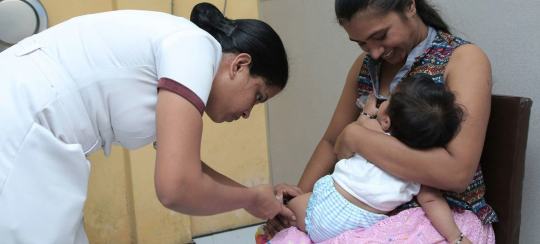
The number of lives lost due to viral hepatitis infections is increasing and already accounts for 3,500 deaths daily, according to a report by the World Health Organization (WHO) released on Tuesday.
The disease is the second leading infectious cause of death globally, with 1.3 million deaths per year, the same as tuberculosis, another top infectious killer, according to the World Health Organization (WHO) 2024 Global Hepatitis Report.
“This report paints a troubling picture,” said WHO Director-General Tedros Adhanom Ghebreyesus. “Despite progress globally in preventing hepatitis infections, deaths are rising because far too few people with hepatitis are being diagnosed and treated.”
Swift course correction
Even though better tools for diagnosis and treatment are available and product prices are decreasing, testing and treatment coverage rates have stalled, the UN health agency stated in the report, released at the World Hepatitis Summit.
But, reaching the WHO elimination goal by 2030 should still be achievable, if swift action is taken now, the agency said.
“WHO is committed to supporting countries to use all the tools at their disposal – at access prices – to save lives and turn this trend around,” the UN health agency chief said.

The waiting area at a health clinic in Rwanda. Hepatitis B birth-dose immunization coverage is only 45 per cent globally, with less than 20 per cent coverage in the WHO African region.
Spike in deaths
More than 6,000 people are getting newly infected with viral hepatitis each day, according to the report. New data from 187 countries show that the estimated number of deaths from viral hepatitis increased from 1.1 million in 2019 to 1.3 million in 2022. Of these, 83 per cent were caused by hepatitis B and 17 per cent by hepatitis C. Updated WHO estimates indicate that 254 million people live with hepatitis B and 50 million with hepatitis C in 2022. Half the burden of chronic hepatitis B and C infections is among people 30 and 54 years old, with 12 per cent among children. Men account for 58 per cent of all cases.
Gaps in diagnosis and treatment
Across all regions, only 13 per cent of people living with chronic hepatitis B infection had been diagnosed and approximately three per cent, or seven million, had received antiviral therapy at the end of 2022, falling far below global targets to treat 80 per cent of people living with chronic hepatitis B and hepatitis C by 2030. The burden of viral hepatitis also varies regionally. The WHO African Region bears 63 per cent of new hepatitis B infections, yet despite this burden, only 18 per cent of newborns in the region receive the hepatitis B birth-dose vaccination. In the western Pacific region, which accounts for 47 per cent of hepatitis B deaths, treatment coverage stands at 23 per cent among people diagnosed, which is far too low to reduce mortality. In addition, despite the availability of affordable generic viral hepatitis medicines, many countries fail to procure them at these lower prices.
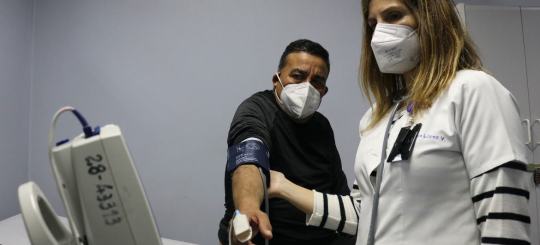
© PAHO
In Chile, new hepatitis treatments mean around 98 per cent of patients recover completely.
Eradicating the epidemic
The WHO report outlines a series of actions to advance a public health approach to viral hepatitis, designed to accelerate progress towards ending the epidemic by 2030. They include expanding access to testing and diagnostics, strengthening primary care prevention efforts and shifting from policies to implementation for equitable treatment. But funding remains a challenge, the agency said, with current levels insufficient to meet the needs. WHO said this arises from a combination of factors, including limited awareness of cost-saving interventions and tools and competing health priorities. The new report also highlights strategies for countries to address these inequities and access the tools at the most affordable prices available.
SDG 3: HEALTHIER GLOBAL POPULATION
Promote mental health and wellbeing and strengthen the prevention and treatment of substance abuse
Reduce the number of deaths and illnesses from pollution, contamination and tobacco
Achieve universal health coverage and provide access to affordable, essential vaccines and medicines
Reduce global maternal mortality rate to less than 70 per 100,000 live births and under-five mortality to at least 25 per 1,000 live births
End epidemics of AIDS, tuberculosis and malaria and combat hepatitis and other communicable diseases
Sustainable development hinges on ensuring healthy lives and promoting wellbeing at all ages.

#world health organization (who)#campaign#preventing hepatitis#viral hepatitis infections#cost-saving interventions#generic viral hepatitis medicines#hepatitis c#hepatitis a#hepatitis b
0 notes
Text
Paving the way for a sustainable future
As we passed the critical milestone of the mid-point in the implementation of the 2030 Agenda for Sustainable Development, impactful transformation remains central to the ongoing efforts to advance all three dimensions of sustainable development – social, economic, and environmental – to achieve peace, prosperity, progress, and sustainability for all. Among others, COVID-19, conflicts, geopolitical tensions, and humanitarian crises in various parts of the world have posed severe challenges to these efforts and derailed implementation of the SDGs by 2030. Building on the momentum gained from the September 2023 SDG Summit is important in effectively tackling the triple planetary crises of climate change, biodiversity loss and pollution.
Now, as we set our attention on the Summit of the Future in September 2024, sustainability is more than ever key for critical sectors of the economy to meaningfully contribute to a prosperous future for present and future generations. The foundation of the future of commerce must be marked by environmental responsibility. We must promote sustainable production and consumption in every facet of human existence. Economic prosperity is intertwined with sustainability. Sustainable business models must, therefore, be promoted in all economic activities.
Sustainability also means ensuring that the benefits of progress are shared equitably, leaving no one behind. The debt crisis – a development crisis – has further exacerbated the socio-economic disparities in the world. Therefore, addressing debt sustainability as an avenue to improve socio-economic equality should be central to the focus on building a sustainable future. Sustainable transportation, infrastructure, tourism, and energy as well as debt sustainability are all critical avenues to attaining such a future.
In this regard, the President of the General Assembly for its seventy-eighth session, H.E. Mr. Dennis Francis, will convene the following meetings as part of the first-ever Sustainability Week, at United Nations Headquarters in New York:

youtube
High-level thematic debate on debt sustainability and socio-economic equality for all
15 April 2024, 3:00p.m.
General Assembly Hall, UN Headquarters, New York
Objective - Format - Concept note - Focal point

youtube
High-level thematic event on Tourism
16 April 2024, 10:00 am to 1:00 pm and 3:00 pm to 6:00 pm
General Assembly Hall, UN Headquarters, New York
Objective - Format - Concept note - Focal point

High-level meeting on Sustainable Transport
17 April 2024, 10:00a.m.
General Assembly Hall, UN Headquarters, New York
Objective - Format - Concept note - Focal point

Informal dialogue on Building global resilience and promoting sustainable development through infrastructure connectivity
18 April 2024, 10:00 am to 1:00 pm and 3:00 pm to 6:00 pm
General Assembly Hall, UN Headquarters, New York
Objective - Format - Concept note - Focal point

Global stocktaking marking the completion of the UN Decade of Sustainable Energy for All to further accelerate the implementation of SDG 7 of the 2030 Agenda for Sustainable Development.
19 April 2024, 10:00 am to 1:00 pm and 3:00 pm to 6:00 pm
General Assembly Hall, UN Headquarters, New York
Objective - Format - Concept note - Focal point
#ungasustainabilityweek#sustainable tourism#sustainable development goals#sustainable transport#sustainable energy#sustainability#sustainable infrastructure#united nations general assembly#sustainablilityweek#Youtube
0 notes
Text
Remarks by the United Nations General Assembly President on behalf the Commemoration of the International Day of Zero Waste 2024; March 30th.
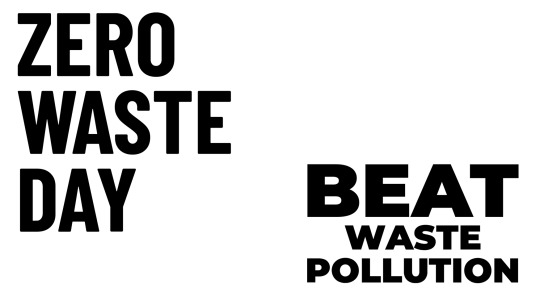
Your Excellency, Sedat Önal, Permanent Representative of the Republic of Türkiye to the United Nations, Ms. Ligia Noronha, Head of UNEP New York Office, Ms. Mr. Michal Mlynár, Acting Executive Director of UN-Habitat, Excellencies, Ladies and Gentlemen,
Let me begin by commending the Permanent Mission of the Republic of Türkiye, the United Nations Environment Programme, and UN-Habitat for co-organizing today’s event – marking the International Day of Zero Waste. We are all deeply appreciative of your ongoing efforts to promote zero-waste initiatives – contributing to advancement of the 2030 Agenda for Sustainable Development. I think it more than appropriate to pay tribute to the distinguished First Lady of the Republic of Türkiye, Ms. Emine Erdoğan, the protagonist and initiator of the Zero Waste project in her own country. It was the astounding success of this that motivated the General Assembly to the adoption of a resolution tabled by the Republic of Türkiye – declaring 30 March as the International Day of Zero Waste.
Excellencies, The numbers and trends speak for themselves in describing the situation as nothing short of harrowing: 2.24 billion tons of municipal solid waste are generated annually, around 931 million tons of food is lost or wasted each year, up to 14 million tons of plastic waste enters aquatic ecosystems,
and food loss and waste accounts for up to 10 per cent of all greenhouse gas emissions – significantly contributing to the climate crisis. Without urgent action, it is projected that annual municipal solid waste generation will hit 3.8 billion tons by 2050. Moreover – if we cling to the business-as-usual mentality – we will have more plastic than fish in the ocean by 2050.
Excellencies, Today – as we commemorate this important day – we urgently need to pause and rethink the unsustainable linear development model of “take, make and dispose” we have been so actively pursuing. It is high time we replace that model with sustainable practices of production and consumption to minimize our ecological footprint – including adopting a circular approach that promotes a resource efficiency model of reduce, reuse and recycle.
To achieve this, we must shift our perspective and accelerate our efforts to develop and implement zero-waste initiatives to foster the environmentally sound management of waste; the minimization of waste; and – where feasible – the total prevention of waste. Such a societal shift should not be a burden. Rather, it should be seen as an opportunity not only to mitigate environmental harm but also to foster innovation, create green jobs, and promote social inclusion. It should also be viewed as an opportunity to invest in sustainable infrastructure, prioritize eco-friendly technologies, and empower communities to become true stewards of their own environment. Allow me to also reiterate the commitments made by the world leaders in the 2023 SDG Summit political declaration – which acknowledged the serious threats posed by plastic, air, and chemical pollution, and expressed firm support for an international legally binding instrument on plastic pollution. I am also deeply grateful to share this moment with a youth representative. The youth are the change-makers. Their perspectives and actions are absolutely critical in our efforts to reach zero waste – and they deserve a say on such matters that have a life-changing impact on their future.
Meeting our zero waste objectives and targets requires a comprehensive multi-stakeholders approach, at all levels – from grassroots initiatives to national policies, from corporate boardrooms to international fora. Our approach must also square the circle to encompass policy alignment, knowledge sharing, capacity-building, resource mobilization, and technology transfer. Importantly – and in the true spirit of leaving no one behind – our commitment and indeed our transition to Zero Waste must be beneficial to all, especially countries in special situations.
Excellencies, Ladies and Gentlemen, Let me close by reiterating that our commemoration today is rooted in a robust commitment to pursue and attain sustainability within the framework of the 2030 Agenda – through, among other things, converting to sustainable patterns of production and consumption. To this end, sustainability remains one of the core priorities of my Presidency – the full manifestation of which will be rolled out during the inaugural Sustainability Week I will be convening from 15 to 19 April. I envision that this Week of back-to-back high-level engagements will spark in-depth discussions on transport, tourism, energy, infrastructure, and debt sustainability and socio-economic equality – propelling substantial progress in these key sectors of the economy.
I further expect that Zero Waste initiatives – with their cross-cutting relevance across these sectors – will feature prominently in the discussions. Furthermore, it is my sincere hope that the harvest from this Week will both inform the deliberations of the Summit of the Future and accelerate momentum towards attaining all the SDGs. The journey towards Zero Waste does not by any means involve a simple unplanned destination – but rather, a continuous process of learning, adaptation and innovation. As the President of the General Assembly, I will play my part – and I call upon us all to harness the power of collective action and solidarity to turn the tide on waste.
I wish you all a fruitful discussion.
I thank you.
H.E Mr. Dennis Francis; United Nations General Assembly President.
#waste management#international day of zero waste#30 march#zero-waste initiatives#take action#zero waste#industrial waste#municipal solid waste#solid waste#Statements#united nations general assembly
0 notes